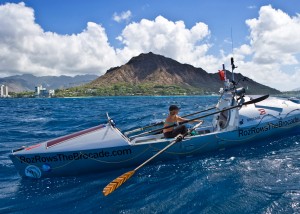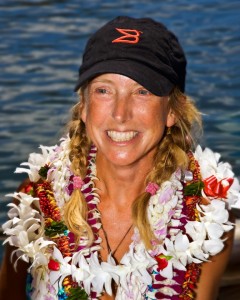
How’s this for a daily routine? Up at dawn. Row for three hours. Rest one hour. Repeat the pattern twice until sunset. Then go to sleep. And all this on your own, in a tiny rowing boat in the middle of the world’s largest ocean. For month after month after month.
This is what Roz Savage has been doing in her attempts to row the Pacific single-handedly. She has already completed the first two stages, from California to Hawaii, and then from Hawaii to the Pacific island of Kiribati. Now she is about to undertake the final and in many ways most difficult section, on to Australia.
In person, Roz is a petite blonde 42-year-old with an infectious, slightly giggly laugh. Compared to the other ocean-rower I know, Jim Shekhdar, a bearded man-mountain who was the first man to cross the Pacific solo and unsupported, she might seem an unlikely contender for one of the toughest journeys on the planet.
So how did she find herself rowing the Pacific? Well, as she puts it , she ‘warmed up by rowing the Atlantic first’. In 2005 she set off from the Canary Islands into ‘a lot of weather’. It was the year of hurricane Katrina and the weather systems over the Atlantic were in turmoil, so she had a memorably tough crossing. ‘I wanted to get out of my comfort zone – and I certainly did!’
Only a daily satellite phone call to her devoted mum kept her going – and her continual blogging. For Roz is a very techno-literate adventurer. Early on she decided to post a daily blog whenever she rowed – a habit she’s kept going across the Pacific. A legion of devoted fans around the world have tracked her daily movements, whether she’s getting blown backwards, has decided to row naked to avoid clothes sores, or is wrestling with the desalination equipment.
A sample extract reads: ‘My right buttock has had more adventures this trip than some people have in a lifetime. Having been featured on this blog at the peak of the red rash/baboon bottom crisis, it then went on to fall victim to my one slip- up of the trip when I lost my footing and punctured the skin…….’
However difficult the Pacific may have been, she still views the Atlantic as her first and really tough introduction to rowing. For a start everything kept breaking: all four oars, her cooking stove, navigation equipment and – worst of all, she says – her MP3 player. There’s nothing quite like the pounding a small 20-foot boat can take from the waves, and a great deal of time between rowing shifts was spent trying to stick the boat together again; without outside assistance of course, for this had to be a solo row.
Far harder was the psychological test. Jim Shekhdar once compared ocean rowing to mountaineering: mountaineers have to psych themselves up for a brief 48-hour summit attempt window, when they push themselves out on the edge; but for ocean rowers that ‘extreme window’ can go on for months and months. It needs extraordinary mental strength.
This was where Roz found she had to dig deep: ‘I wanted to be tested, to see if I could handle an extreme situation, like the Atlantic – and at the start I couldn’t. Some of the lessons were just to full-on at the time for me to absorb. It took another 18 months to realise what I had learnt.’ Chief among these was the overriding need to ‘live for the moment’ – to avoid what she describes as her natural tendency for emotional introspection and instead just stay focused on what needed doing right away – with a strict accompanying routine, ‘or I would just have stayed lying in bed’ (the rowing boat has a tiny indoor cabin, just long enough to sleep in, but by no means comfortable).

She had a fair amount to introspect about, having just come through a divorce and a complete change of life. Only a short while previously, she had been working as an investment banker in the City of London, with a large, comfortable house and lifestyle to match. Then one day she had a Damascene moment: ‘I had a job, husband and a little red sports car. It seemed the perfect existence, but I would sit on the commuter train coming back from work wondering if this was really what it was all about.’ She decided to write out two versions of her obituary: one was the one she wanted to have, adventurous and risk-taking; the other was what would happen if she continued on the way she was, secure but unfulfilled.
Which is when I met her. For as her first ‘jump-from-the-plane’, Roz decided to join one of my expeditions to Peru to look for Inca ruins. Even at that early stage, I could tell she was a driven and tough adventurer; she joined our advance guard party who went off hacking their way into the cloud forest with machetes. I never imagined, however, that she would someday take on anything as epic as the Pacific.
For despite having rowed the Atlantic already, the Pacific is a whole different order of magnitude. As Roz says, ‘it’s basically half the planet.’ And it’s not just the size. While the ocean currents will eventually take you right across the Atlantic from the Canaries to the Bahamas without lifting an oar, in the Pacific they swirl around like a set of whirlpools – it’s easy to be swept back and round again along the way you came.
In some ways it’s remarkable that she has persevered with the Pacific at all, given the experience she had on her first attempt in 2007: not long into the journey she capsized three times running within 24 hours. Amazingly, once she got herself upright again, she still managed to blog about the experience – so alarming one of her fans that he alerted the coastguard, who arrived to enforce a rather unwanted rescue after the event. When she next set off in 2008, she had problems just getting away from the Californian coast – the winds blew her back in a zig-zag: ‘I thought I’d end up landing in Mexico – which would have been embarrassing.’ But instead she managed a landfall in Hawaii, after a total of 99 days at sea.
I asked why she has chosen to break the journey into three stages, each of which lasts about three months. While this might make it seem easier to some, it actually brings considerable difficulties over the more direct route: she has to find and make landfall on relatively small islands in the middle of a very large ocean – and before each annual stage, she has to fly out with her backup crew and restock both equipment and herself.

The answer is tied in to her role as a self-styled ‘eco-adventurer’. Roz’s travels across the ocean have left a committed campaigner for green causes. Nothing bonds you closer to the sea that floating about it for months like a cork on the waves – and she has seen so much pollution up close that she wanted to bring that message home to as many people as possible.
By doing the Pacific in stages, she’s been able to use each departure and landfall as a way of bringing publicity to the causes she holds dear: the ‘great garbage patch’ of plastic that has been collecting in the Pacific, made up of tiny plastic particles that are entering the food chain – and the rising sea levels that in a few years may completely obliterate some of the Pacific Islands, like Kiribati from which she is making the final stage of her voyage.
However, unlike many eco-warriors, her message is not all doom – indeed she sees her rowing as a symbol of what can be done: ‘the small green actions that we can all take, like recycling and consuming less energy, may seem futile – but taken together they are like all the small individual oar-strokes have taken me across oceans.
I wonder what she plans to do next after the Pacific? ‘Well, I’ve still got the Indian Ocean left! But ask me again once I reach Australia – I might be totally over the whole ocean-rowing thing by then. And I would love to go to the two Poles as well. The main question is: where can I be of most use? I would want to go somewhere that inspires people to be more environmentally conscious.’
And does she feel that her decision to seek a riskier life has paid off, given that she now she has no home and most of her possessions are in storage with her mother?
‘I had a Eureka moment towards the end of my last Pacific row, when my GPS told me that I was finally crossing the equator. Some friends had given me a bottle of champagne and as I cracked it open, I felt, yes, all my dreams really have come true. This is the way I want to live.’
.
Roz’s book Rowing The Atlantic: Lessons Learned On The Open Ocean has recently been published by Simon & Schuster
